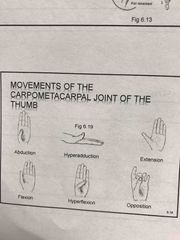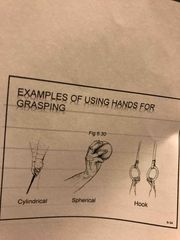![]()
![]()
![]()
Use LEFT and RIGHT arrow keys to navigate between flashcards;
Use UP and DOWN arrow keys to flip the card;
H to show hint;
A reads text to speech;
58 Cards in this Set
- Front
- Back
|
3 joints of elbow |
Humeroulnar Humeroradial Proximal Radioulnarra |
|
|
Radioulnar joint |
Pivot joint, radius articulates with head of ulna. Pronation and supination |
|
|
Muscles of elbow and radioulnar joints |
Anterior (elbow): biceps brachii brachialis, brachioradialis, pronator teres Anterior (wrist): pronator quadratis Posterior; triceps brachii, aroneus, supinator |
|
|
Biceps brachii |
Flexes and supinates the forearm |
|
|
Brachialis |
Flexion at elbow |
|
|
Brachioradialis |
Contributes to elbow flexion |
|
|
Pronator teres |
Primates the forearm, assists in elbow flexion |
|
|
Pronator quadratus |
Pronation of forearm |
|
|
Triceps brachii |
Powerful elbow extension |
|
|
Supinator |
Supinator of forearm |
|
|
Aconeus |
Works with triceps to extend forearm |
|
|
Flexion of elbow |
Brachialis involved in all movements. Biceps brachii most active in supination, least with pronation |
|
|
Radiocarpal joint |
Condyloid joint 4 ligaments: Volare radiocarpal, dorsal radiocarpal, ulnar collateral, radial collateral Flexion, extension, radial and ulnar deviation |
|
|
Midcarpal and intercarpal joints |
Proximal row of 4 carpal bones articulate with 4 carpal bones of distal row. Permits only slight gliding. |
|
|
Carpometacarpal and internet carpal joints |
Thumb is prime example of a saddle joint. Joints between the bones are irregular |
|
|
Movements of thumb |

Back (Definition) |
|
|
Movements of carpometacarpal and intermetacarpal joints |
Because of short ligaments, motion is almost non existent. Limited to slight gliding. 5th carpometacarpal joint is slightly more mobile |
|
|
Metacarpophalangeal joints |
Joints at bases of four fingers. Condyloid joint. Protected by collateral ligaments. Also a dorsal ligament. Movements: adduction/Abduction, flexion/extension |
|
|
Metacarpophalangeal joints |
Joints at bases of four fingers. Condyloid joint. Protected by collateral ligaments. Also a dorsal ligament. Movements: adduction/Abduction, flexion/extension |
|
|
Movements of metacarpophalangeal joints of thumb |
Flexion: volar surface of thumb approaches base of thumb Extension: return movement |
|
|
Interphalangeal joints |
Joints between adjacent phalange of any of the five digits. All are hinge joints, flexion and extension Strengthen by collateral ligaments and in front by volar ligament |
|
|
Flexor carpi radialis |
Flexes wrist Radial deviation |
|
|
Flexor carpi ulnaris |
Flexes wrist Ulnar deviation |
|
|
Palmaris longus |
Weakly flexes wrist |
|
|
Extensor carpi radialis |
Extends wrist Radial deviation |
|
|
Extensor carpi ulnaris |
Extends wrist Ulnar deviation |
|
|
Extensor digitorum |
Extends fingers and wrist |
|
|
Extensor digit minimi |
Extends little finger and wrist |
|
|
Extensor digit minimi |
Extends little finger and wrist |
|
|
Flexor digitorum superficialis |
Flexes fingers and wrist |
|
|
Flexor digitorum profundus |
Flexes fingers and wrist |
|
|
Flexor pollicis longus |
Flexes thumb |
|
|
Extensor pollicis longus |
Extends thumb |
|
|
Extensor indicis |
Extends index finger |
|
|
Extensor indicis |
Extends index finger |
|
|
Abductors pollicis longus |
Abduct thumb |
|
|
Extensor pollicis brevis |
Extends thumb |
|
|
Abductor pollicis brevis |
Abduct thumb |
|
|
Abductor pollicis brevis |
Abduct thumb |
|
|
Flexor pollicis brevis |
Flexes thumb |
|
|
Opponents pollicis |
Opposition of thumb |
|
|
Abductor digit minimi |
Abduct little finger |
|
|
Abductor digit minimi |
Abduct little finger |
|
|
Flexor digiti minimi |
Flexes little finger |
|
|
Abductor digit minimi |
Abduct little finger |
|
|
Flexor digiti minimi |
Flexes little finger |
|
|
Opponents digiti minimi |
Opposition for little fingers |
|
|
Long finger muscles... |
Do not have the length to permit full ROM in joints of fingers and wrist at same time |
|
|
Types of grasping |

Back (Definition) |
|
|
Fractures |
Result of direct blow or falling on outstretched hand. Usually both ulna and radius fracture |
|
|
Fractures |
Result of direct blow or falling on outstretched hand. Usually both ulna and radius fracture |
|
|
Elbow dislocation and fracture |
Falling on outstretched hand. Most common is backward displacement of ulna and radius in relation to humerus |
|
|
Fractures |
Result of direct blow or falling on outstretched hand. Usually both ulna and radius fracture |
|
|
Elbow dislocation and fracture |
Falling on outstretched hand. Most common is backward displacement of ulna and radius in relation to humerus |
|
|
Strained or sprained wrist |
From falling on palm of hand with wrist hyperextended |
|
|
Carpal tunnel syndrome |
Nerve and blood vessel compression as they pass through carpal arch and transverse carpal ligament. Indicators are pain, numbing of fingers |
|
|
Avulsion fracture |
External force applied to tendon pulls off a piece of bone From rapid pronation or supination or high energy flexion of fingers |
|
|
Epicondylitis |
Lateral epicondylitis: tennis elbow Medial epicondylitis: little league elbow Micro traumas or tears in muscle and soft tissue at proximal attachments |

